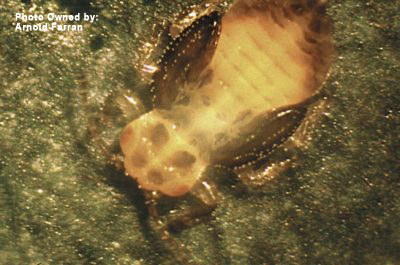Glycaspis spp. (psyllid), G. brimblecombi (redgum lerp psyllid)
Psyllids are plant‑juice sucking Homoptera in the insect family Psyllidae. During its nymphal (immature) stage, this type of psyllid forms a protective cover called a “lerp”, which makes older nymphs look similar to armored scales. However, unlike scale coverings, the lerp is composed mostly of crystallized honeydew, the sugary water that homopteran insects excrete, and resemble small white, roundish caps on leaves that grow up to about 1/8 inch (3 mm) diameter and 1/12 inch (2 mm) tall. The nymph underneath each lerp is yellow or brownish and looks similar to a wingless aphid. Older nymphs stay beneath their lerp and generally don’t move. Adult lerp psyllids are slender insects that are about 1/8 inch (3 mm) long. Their bodies are light green with orangish and yellow blotches and they have clear wings that are usually held rooflike over their abdomen. The adults differ from other psyllids found in California in that they have relatively long forward projections (called genal cones) on each side of their head below their eyes. Females lay tiny, yellowish, ovoid eggs, singly or in scattered groups.
Amoung their host plants are River red gum (Eucalyptus camaldulensis) is a primary host of red gum lerp psyllid (hence the name) and sugar gum (E. cladocalyx). Other species of lerp-producing psyllids attack many other species.
They are found in Australia, California and any place eucalyptus are growing.
As with other psyllids, redgum lerp psyllid develops through gradual metamorphosis, which includes the egg, several increasingly larger nymphal stages, and the adult. There is no pupal stage. Females prefer to lay their eggs on succulent leaves and young shoots, so population increases often follow the production of new plant growth. However, all psyllid life stages can occur on both new and mature foliage. Young nymphs may be observed excreting gelatinous honeydew from their rear end. Older nymphs are concealed beneath their lerp. In its native Australia, the psyllid has 2 to 4 generations a year, and a similar number of generations would be expected in California. Development time from egg to adult varies from several weeks during warm weather to several months during prolonged cool temperatures. In mild coastal areas, all stages can be present throughout the year.
Look for White, roundish caps on leaves that grow up to about 1/8 inch. High populations of psyllids secrete copious amounts of honeydew. A blackish sooty mold grows on the honeydew‑covered surfaces. High psyllid populations can cause severe leaf drop. Extensive defoliation weakens trees and increases tree susceptibility to wood‑boring pests such as longhorned beetles.


